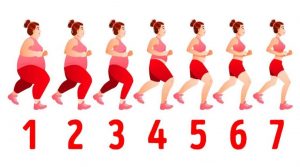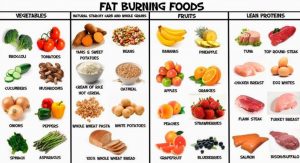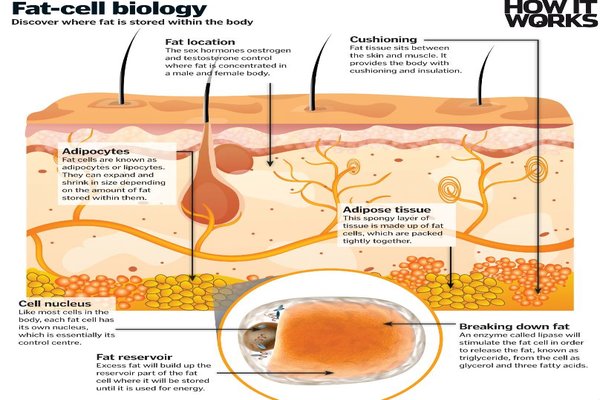Tips & Tricks
When fat cells “burn” fat, they shrink but do not entirely disappear. When you eat in excess of what you burn, they refill, and you gain fat. You avoid gaining fat by keeping a balance between calories taken in and those burned. To lose fat, you have to create a deficit by eating fewer calories than you burn. This drives your body to turn to stored fat to supply the missing calories.
Although fat provides about 60 % of the energy you use when resting, it can not sustain all of your body’s functions. Your brain, nerve and red blood cells need glucose to operate, and fat supplies minimal amount of glucose. If you go on a starvation or very-low calorie diet, your body will turn to lean muscle, which will will be burned to get the glucose it needs.
A pound of body fat is equal to 3,500 calories, so when you eat this many calories fewer than you burn, you lose a pound. But, even if you burn 2,000 calories per day, and take in no food or drink (besides water) you will not successfully lose 0.6 pounds of fat per day. This is because your body will also eat into lean muscle to fuel necessary functions. About 25% of every pound lost when you don’t exercise, will come from lean muscle mass. You cannot lose more than one-half of a pound of pure fat per day, even if you drink nothing but water.
To help prevent your body from using lean muscle mass for energy to fuel your brain and central nervous system, you should strength train as you reduce calories. This sends a message to your body that the muscle is necessary for basic function. Aim for at least two workouts per week that address all the major muscle groups.
Your body also needs some carbohydrates in your diet to completely break down fat. You may cut back on carbohydrates slightly when reducing calories, but do not eliminate them altogether. Whole grains, vegetables and fruits are healthy sources.
The biggest enemy of fat is muscle. People who tend to be over fat tend to be under muscled. Why? Every pound of muscle lost will actually slow down your metabolism by around 60 calories per day. For most people a combination of life style and genetics attributes to 5 to 10 pounds of muscle being stripped from the body every decade. This slows down the metabolism by 300 to 600 calories per day making it more difficult to stay lean. The primary bio-marker of aging is muscle atrophy (wastage). It has a negative effect on your metabolism and it can also have a negative effect on the Endocrine (hormonal) system, which essential for your body’s ability to maintain a healthy physical condition.
How to workout to burn more fat?

When we exercise, our bodies will start burning calories, but the calories that are burned are the calories from carbohydrates in our system. In order to burn calories from your stored fat, your body requires the presence of oxygen. There is a certain amount of oxygen that your body needs in order to start burning fat. The only way for you to measure the amount needed for your body, is to keep up with your target heart rate during the exercise. If you continue to only burn calories from carbohydrates, you will lose mostly “water weight” which decreases your metabolism. Think of the calories that are burned from carbohydrates as your energy calories. If you have used too many carbohydrates calories, then your muscles will not receive enough energy to increase your metabolism, which indirectly burns fat. Therefore you must increase your calorie intake when you are on an exercise program to replace your burned energy calories.
During aerobic exercise, your body goes through several stages before it reaches the point where you are burning fat. You will hear people say that you are only burning sugar (carbohydrates) not fat during the first 10 minutes of exercise. This is true to a certain extent. You will continue to burn sugar past the 10 minute mark if you are not working out hard enough for your body to need more oxygen; or you are working out too hard and you can not supply your body with enough oxygen for fat burning. When you exercise you must move at a steady pace (not too fast, not too slow) so your body will utilize your stored fat (not carbohydrates or sugar) as its energy source. Just because you reached the fat burning stage, does not mean you will stay there. Staying at the fat burning stage, once again depends on if you are moving at a pace that is right for your body. Make sure that you are within your target heart rate range.
In order to burn fat calories hours after you have finished working out, you should do anaerobic exercises of weight training. Weight training is the key for burning fat at rest. It is an anaerobic activity that will cause you to burn more calories than aerobic exercise. The calories that you are burning during weight training exercises are mostly calories from carbohydrates, but the calories you burn after that, at rest, are mostly calories from fat. The reason you are burning fat at rest is because weight training increases your metabolism which uses your stored fat as energy.
To make your body the ultimate fat burning machine you must do aerobic (cardio) and anaerobic (weight training) exercises.
Both aerobic and resistance exercise (weight training) have their benefits. However if you are over 30 resistance exercise done correctly is imperative. This is the only form of exercise which can significantly aid in replacing muscle lost from ageing and poor lifestyle, while burning significant amounts of fat at the same time.
Resistance exercise is anaerobic by nature. This means that the working muscles derive energy primarily from Adenosine triphosphate (ATP) and glycogen without oxygen. This depletes glycogen stores rapidly, so the average individual has only around 20 minutes of stored glycogen available for anaerobic exercise. When burning fat is the primary goal, it is imperative that you don’t train for too long and not to the point where you’re flattened and thoroughly exhausted. If you go over 30 minutes in the gym your body starts running out of glycogen and starts breaking down muscle.
High Intensity Interval Training or HIIT is training where you alternate between intervals of high-intensity and low-intensity exercise.
This type of cardio is less stressful and more effective than conventional cardio sessions performed at low intensity for long duration. Conventional cardio can produce high levels of cortisol which can slow your resting metabolism. Also the metabolism returns back to normal very quickly after low intensity cardio sessions. HIIT training actually helps to minimize cortisol levels and can keep the metabolism high for nearly 12 to 18 hours after training.
When it comes to weight loss, it doesn’t matter what type of fuel you use. What matters is how many calories you burn as opposed to how many calories you take in.
How to eat to burn more fat?

Low blood sugar lowers insulin and removes the inhibition of triglyceride breakdown, leading to the mobilization of fat stores. This is the principle of the weight loss seen in fasting and diets with reduced free sugar. Exercise also puts a demand on the blood sugar and fatty acids leading to rapid breakdown of fat stores.
Fish oils have recently been discovered to increase the utilization of fatty acids by beta oxidation, thus driving levels of triglycerides down
Meal frequency, or how many times you eat each day, affects your overall metabolism. Every time you eat, the body’s calorie-burning engine, also known as metabolism, slightly increases. This is especially true for meals that contain protein. So if you eat five times a day, you’ll experience five metabolic surges a day, rather than just three if you eat only three times a day. And, of course, eating six times per day would be even better than five. This is the only way to lean out without having to drastically reduce calories. Frequent feedings tend to increase the chance that what you eat will be utilized by the body rather than being packed away as body fat.
Eating habits can have a detrimental effect on your metabolism. Eating very little for breakfast and lunch followed by a surge of calories in the evening triggers the body to overcompensate and put away calories in the form of fat in case you starve yourself again tomorrow .You teach your body to become very efficient at storing calories rather than utilizing them. This will not only add to your fat deposits, it’s also bad for your health and will drag down your energy and vitality.
Eat within half an hour after you train including both protein and complex carbohydrates to ensure maximum recovery and stimulation to your metabolism.
If you eat too little at this time, you may actually set yourself back by impeding the recovery, which slows down the metabolism. While supporting the recovery increases it. So the worst thing you can do after a hard workout is to starve yourself.
Keep the carbohydrates low before bed
The body naturally produces a fat-liberating hormone called growth hormone (GH) within the initial 90 minutes of sleep.
GH not only increases fat-burning but it is required to build lean tissue and strengthen the immune system. Simple fast acting carbohydrates inhibit GH release, so it’s ideal to go to bed under one of two scenarios: on an empty stomach or, even better, having consumed only protein and small amounts of complex carbohydrates. This allows blood glucose – the high-tech name for digested carbohydrates circulating in the blood – to remain low, which facilitates the rise in nocturnal GH production.
Eat your last meal no later than 1 to 2 hours before bed maintaining your protein and complex carbohydrate balance.
References:
https://www.livestrong.com/article/383467-how-does-your-body-get-rid-of-fat/
https://www.newyou.ie/blog-new-you.php?title=turning-your-body-into-a-24-7-fat-burning-furnace&post=u95635
https://www.livestrong.com/article/31619-triglyceride-broken-down/
https://www.healthstatus.com/health_blog/body-fat-calculator-2/burning-fat-vs-burning-calories/
https://blog.myfitnesspal.com/how-target-your-heart-rate-get-into-the-fat-burning-zone/
https://health.howstuffworks.com/wellness/diet-fitness/weight-loss/lost-weight.htm
https://www.verywellfit.com/body-into-fat-burning-machine-1231548
https://en.wikipedia.org/wiki/Lipolysis
https://en.wikipedia.org/wiki/Insulin

Leave a Reply